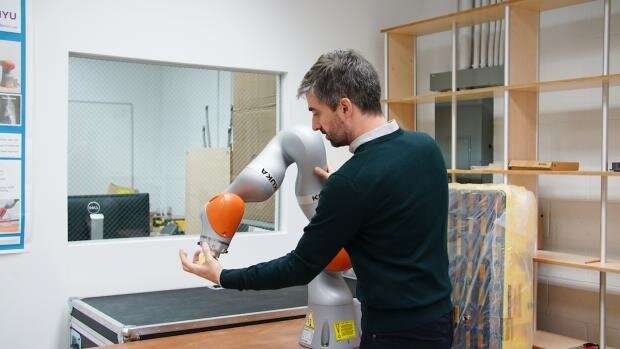5G wireless to connect robots on the ground to AI in the cloud

A research team at the NYU Tandon School of Engineering, with the support of the National Science Foundation's National Robotics Initiative 2.0, is building the foundations of a wireless system that takes advantage of superfast fifth-generation (5G) wireless communications to outsource a mobile robots' artificial intelligence (AI) functions to the edge cloud—the server in the cloud closest to the robot.
The collaborators, all of whom are members of the faculty of NYU Tandon's renowned NYU WIRELESS center for telecommunications research, will design manipulation and locomotion algorithms that address some important technical hurdles to making 5G networks a viable bridge between robot and server.
Shifting AI capabilities from the robot to a remote server offers tantalizing operational benefits, such as allowing robots to perceive the environment, perform complex operations, and make decisions autonomously, all without incurring major energy and weight costs from onboard computational and power-generation equipment.
Comprising Ludovic Righetti, professor in the Departments of Electrical and Computer Engineering and Mechanical and Aerospace Engineering; and Siddharth Garg, Sundeep Rangan and Elza Erkip, professors in the Department of Electrical and Computer Engineering, the team will focus on solving issues of reliability, safety of robotic operation under communication degradation, and scalability to multi-robot systems.
The collaboration brings expertise in robotics (Righetti), computer architecture and computation (Garg), wireless networks (Rangan and Erkip), and information theory (Erkip). Righetti, a new hire at Tandon, will lead the project.
"The goal is to design algorithms that optimally distribute computation between robots and the cloud for guaranteed safe robotic operation," said Erkip.
Rangan explained that while cloud robotics has long been seen as a way to offload power-consuming computation, it has remained elusive for real-time perception and control because of limited bandwidth and high latency of wireless communication systems. He explained that the problem is exacerbated by the need to support the bandwidth-hungry video and LIDAR systems commonly used on robots today.
"5G systems offer the potential for vastly higher data rates, but real-time cloud robotics remains challenging," he said. "A particular difficulty is that 5G communication using the millimeter wave (mmWave) bands are highly susceptible to blockage. As a result, links can have high peak data rates, but may be only intermittently available."
The project considers various aspects of these challenges, including 5G channel modeling in robotics scenarios, dynamic partitioning of tasks between the cloud and robot, and the development of new control algorithms that can exploit high rate links when available—but that also operate when links are blocked.
"The ultimate goal is to help the development of light-weight, autonomous, cloud-connected robotics," said Righetti, adding that outreach activities—including offering the team's algorithms for free—will be a major aspect of demonstrating the unique capabilities of 5G-enabled robotic systems. "We are lowering the barriers of entry for scientists and industries seeking to exploit 5G-enabled robotics by distributing the algorithms we develop through open-source and to industrial partners via NYU WIRELESS."
He explained that the work will include curriculum development based on the research. "This initiative will contribute to the education of undergraduate and graduate students; in fact, we are offering supervised projects with the possibility of working directly on state-of-the-art experimental platforms."



















